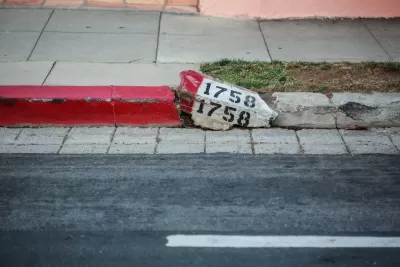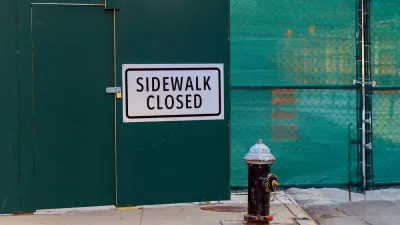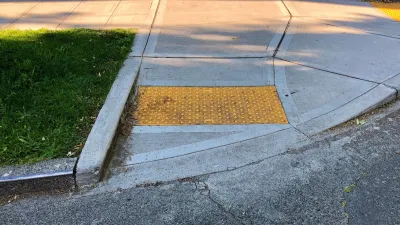In some cities, maintenance of sidewalks is not the responsibility of the city but of adjacent landowners. Philadelphia is finding what a hassle this arrangement can be. With countless blocks in disrepair, everyone is passing the buck.

Back in 1891, the city of Philadelphia adopted an ordinance assigning responsibility for sidewalk maintenance to adjacent landlords. This seemed like a good idea at a time when everyone walked and before laws like the Americans With Disabilities Act required that sidewalks always provide safe passage.
Today, many Philly sidewalks are impassible not just to citizens in wheelchairs, but also to just about anyone short of a mountain goat. And the city is finding, not surprisingly, that landlords and neighborhood associations aren't eager to pay up. The city has tried to fine landlords, but the fines are often paltry compared to the cost of compliance.
Neighborhood groups are searching for creative solutions. One of them suggests a list of "Top-10 Offenders" in case a public display might spur landlords to action.
"[P]articularly outside of Center City, where busted, tree-root shimmed and all-but-obliterated sidewalks are distressingly common. Philadelphia’s walkability is one of its chief strengths—but not on those stretches where sidewalks are in gross disrepair."
FULL STORY: Lots of Philadelphia Sidewalks Are in Horrible Shape — How to Fix Them?

Trump Administration Could Effectively End Housing Voucher Program
Federal officials are eyeing major cuts to the Section 8 program that helps millions of low-income households pay rent.

Planetizen Federal Action Tracker
A weekly monitor of how Trump’s orders and actions are impacting planners and planning in America.

Ken Jennings Launches Transit Web Series
The Jeopardy champ wants you to ride public transit.

Rebuilding Smarter: How LA County Is Guiding Fire-Ravaged Communities Toward Resilience
Los Angeles County is leading a coordinated effort to help fire-impacted communities rebuild with resilience by providing recovery resources, promoting fire-wise design, and aligning reconstruction with broader sustainability and climate goals.

When Borders Blur: Regional Collaboration in Action
As regional challenges outgrow city boundaries, “When Borders Blur” explores how cross-jurisdictional collaboration can drive smarter, more resilient urban planning, sharing real-world lessons from thriving partnerships across North America.

Philadelphia Is Expanding its Network of Roundabouts
Roundabouts are widely shown to decrease traffic speed, reduce congestion, and improve efficiency.
Urban Design for Planners 1: Software Tools
This six-course series explores essential urban design concepts using open source software and equips planners with the tools they need to participate fully in the urban design process.
Planning for Universal Design
Learn the tools for implementing Universal Design in planning regulations.
Ada County Highway District
Clanton & Associates, Inc.
Jessamine County Fiscal Court
Institute for Housing and Urban Development Studies (IHS)
City of Grandview
Harvard GSD Executive Education
Toledo-Lucas County Plan Commissions
Salt Lake City
NYU Wagner Graduate School of Public Service





























